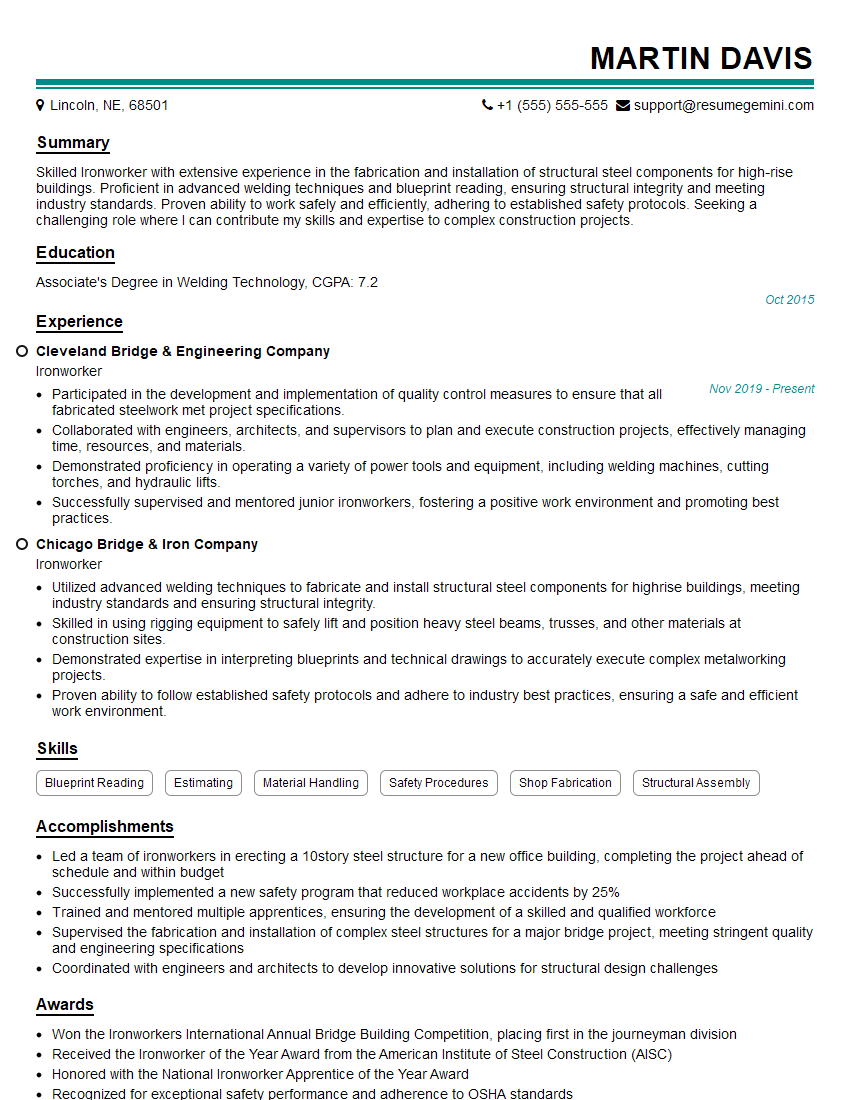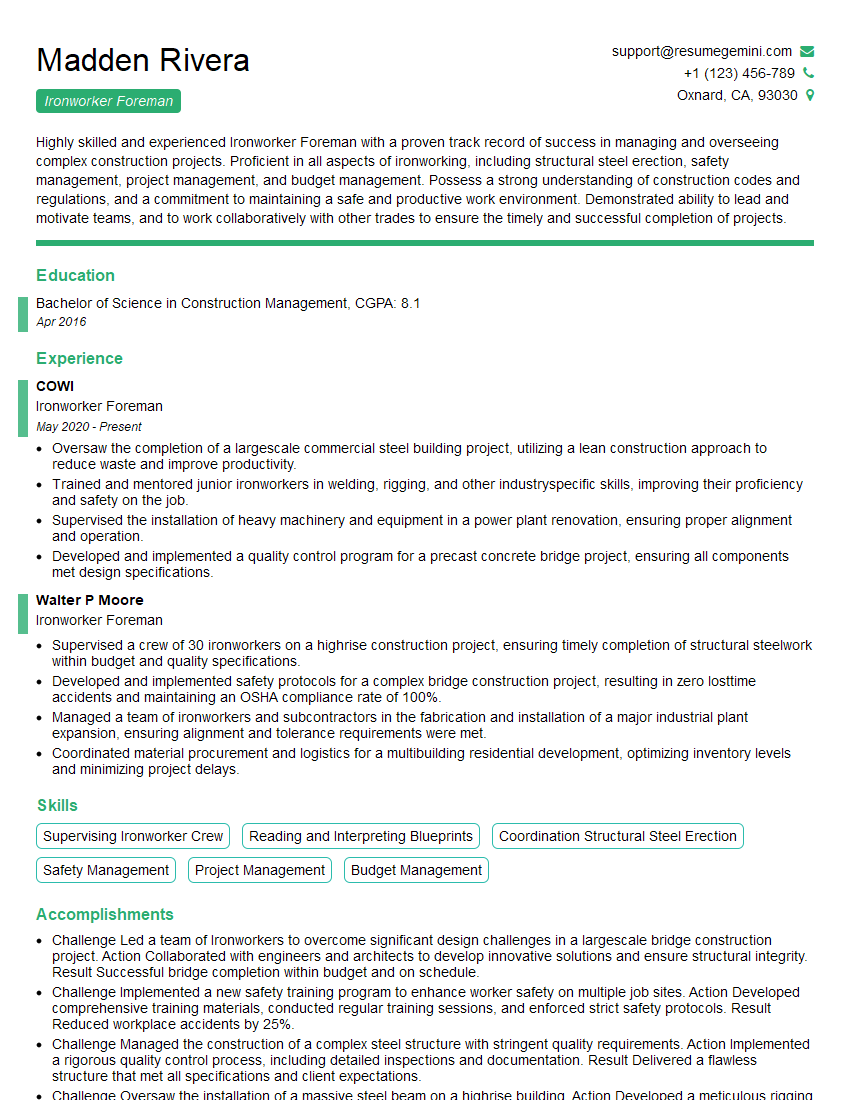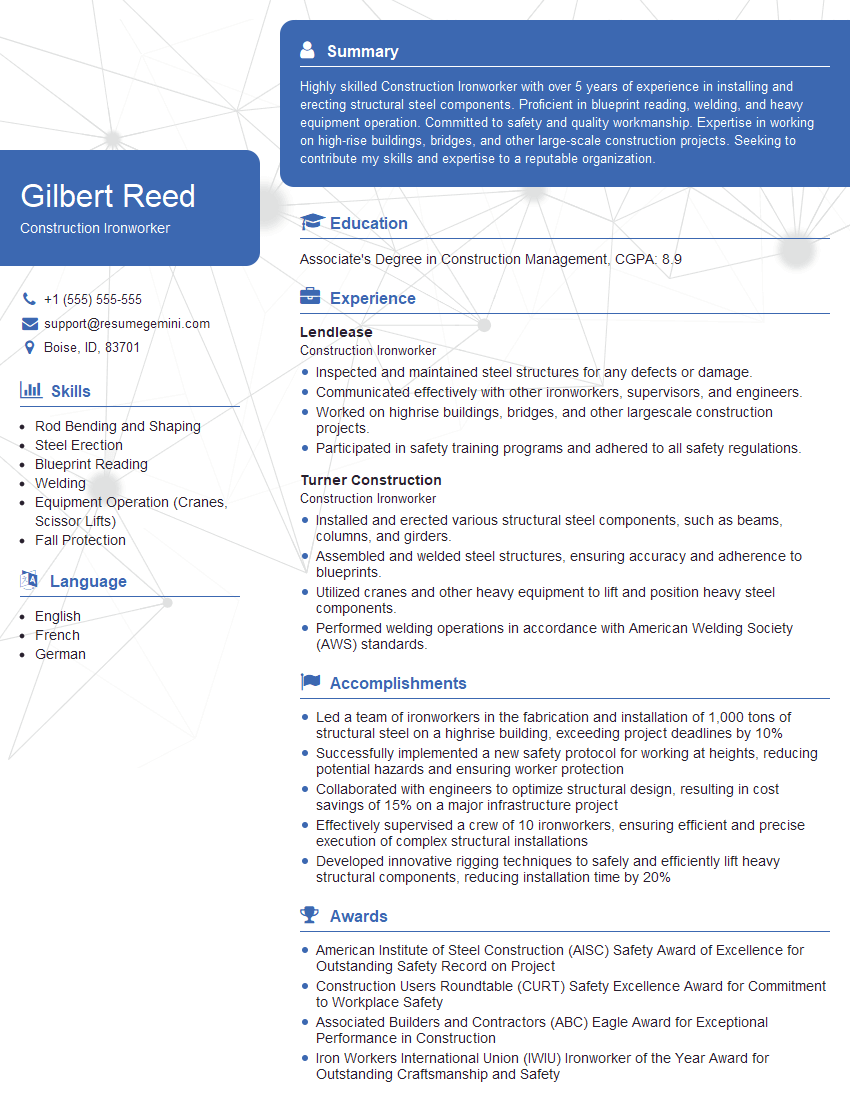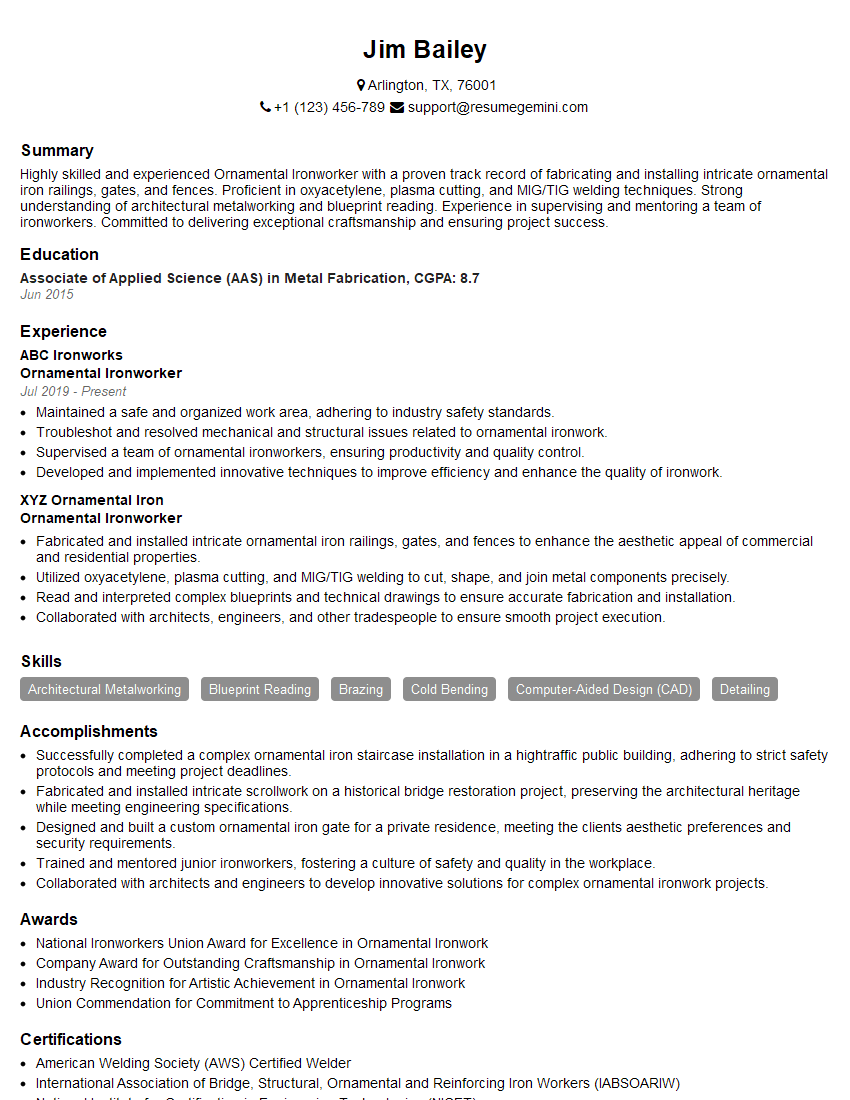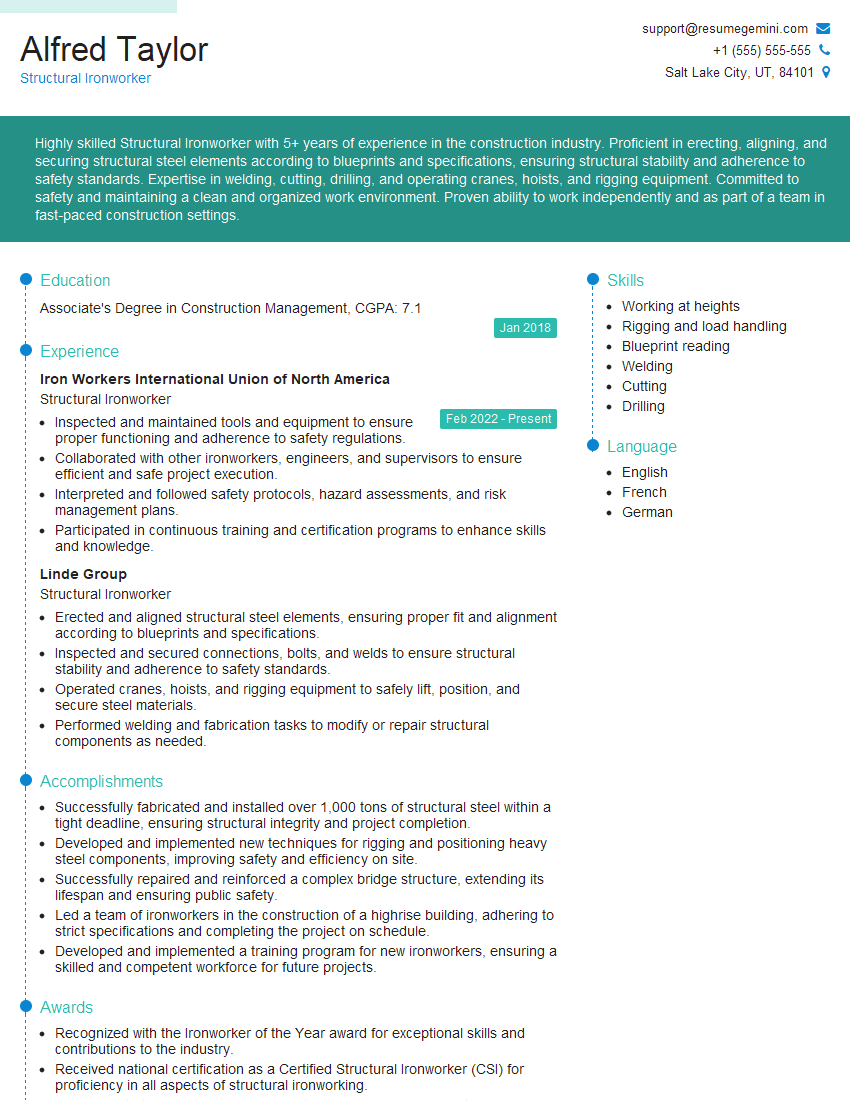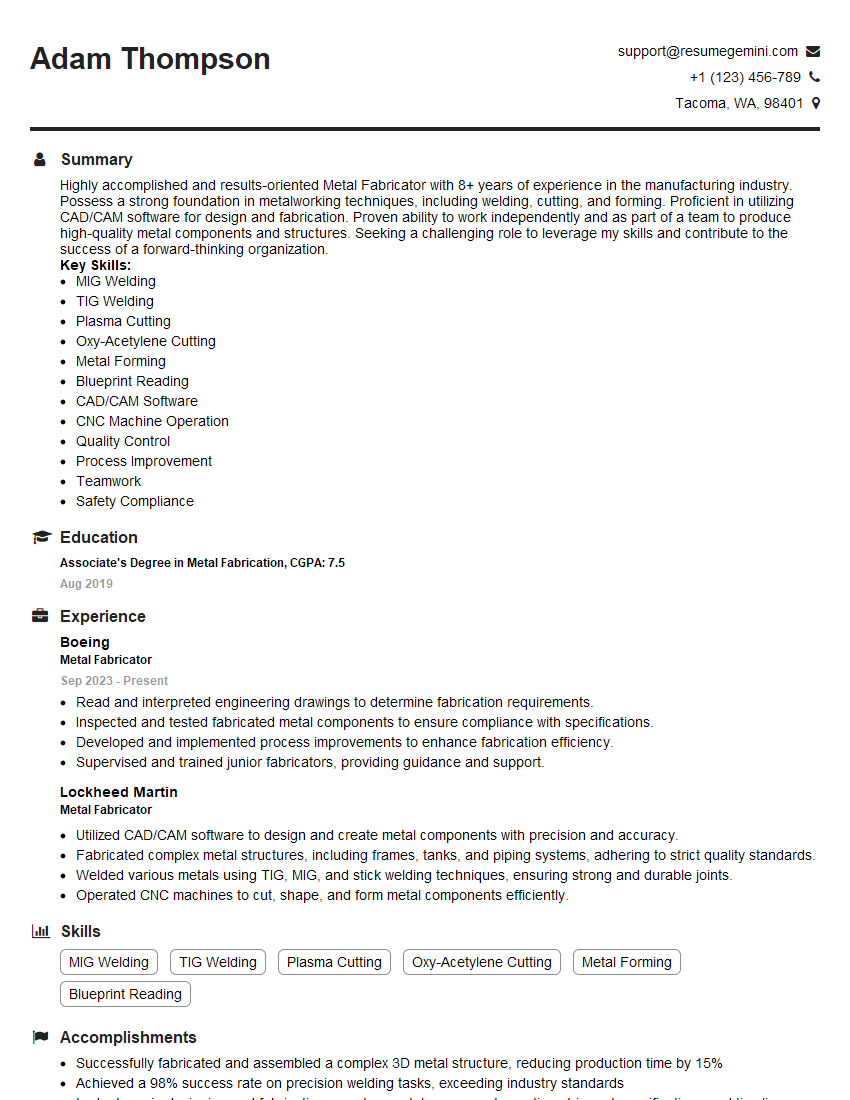Interviews are more than just a Q&A session—they’re a chance to prove your worth. This blog dives into essential Iron Work interview questions and expert tips to help you align your answers with what hiring managers are looking for. Start preparing to shine!
Questions Asked in Iron Work Interview
Q 1. Describe your experience with different types of welding techniques used in ironwork.
My experience encompasses a wide range of welding techniques crucial in ironwork. I’m proficient in both arc welding processes, such as Shielded Metal Arc Welding (SMAW) – commonly known as stick welding – and Gas Metal Arc Welding (GMAW), or MIG welding. SMAW is excellent for outdoor work and various positions, offering versatility, while GMAW is faster and cleaner for many applications. I also have experience with Gas Tungsten Arc Welding (GTAW), or TIG welding, which provides the highest precision for intricate details and thin materials. The choice of technique depends heavily on the project’s requirements, material thickness, and accessibility. For instance, SMAW’s robustness makes it ideal for welding thick sections in a construction site setting, while TIG welding’s precision is perfect for decorative ironwork requiring a smooth, high-quality finish.
Furthermore, I’m familiar with various filler metals and their applications, ensuring I select the optimal materials for the intended outcome. For example, choosing the correct flux-cored wire for outdoor applications prevents corrosion, and knowing the characteristics of different stainless steel filler metals guarantees the desired weld quality in specific projects. My experience extends to understanding the importance of proper weld preparation and post-weld cleaning, critical for ensuring structural integrity and a professional finish.
Q 2. Explain the process of installing reinforcing steel (rebar) in a concrete foundation.
Installing rebar in a concrete foundation is a critical step in ensuring structural stability. The process begins with careful study of the structural drawings to understand the rebar layout, spacing, and overlap requirements. This blueprint reading is paramount, as any error can compromise the foundation’s strength. We then typically start by laying out the base layer of rebar, ensuring proper spacing using chairs or rebar supports to keep it elevated from the formwork’s base. This prevents concrete from covering the bottom of the rebar, ensuring it’s correctly embedded and bonded.
Next, we install the vertical rebar, often tied to the base layer using wire ties. Careful attention to detail is critical here, as proper spacing and overlap are vital. The overlap is typically determined by the rebar’s diameter and specific design requirements. Once the vertical rebar is in place, any additional layers are added as per the plans, and each layer is meticulously tied to the previous one. Throughout the process, we ensure that all rebar is properly positioned, spaced, and adequately supported. A final inspection checks for conformity to specifications before the concrete is poured, ensuring the foundation achieves the necessary strength and durability.
Q 3. What safety precautions are crucial when working at heights on ironwork projects?
Safety is paramount when working at heights. On ironwork projects, this involves adhering strictly to OSHA regulations and employing comprehensive safety measures. This includes but isn’t limited to the mandatory use of fall protection systems, such as harnesses, lanyards, and lifelines connected to secure anchor points. We must always inspect these systems before every use and regularly conduct thorough inspections of all equipment. Scaffolding, if used, needs to be erected and maintained to the highest standards; this includes proper bracing, guardrails, and toeboards.
Beyond fall protection, we must ensure proper use of safety helmets, safety shoes, and gloves. Working at heights often involves using power tools; therefore, additional PPE like eye protection, hearing protection, and respiratory protection is also essential, particularly when working with welding or cutting torches. Before commencing any work at heights, a thorough site assessment is critical to identify and mitigate potential hazards. This ensures we are well-prepared and aware of all safety protocols, and, equally importantly, that our colleagues are too. Effective communication and teamwork are key to a safe working environment.
Q 4. How do you ensure the accuracy and precision of ironwork installations?
Accuracy and precision are fundamental to successful ironwork. We start by meticulously reviewing the plans and specifications to fully understand the design intent. Precise measurements are taken throughout every stage, using accurate measuring tools such as laser levels, tape measures, and squares. Precise cutting of materials is achieved through the use of machinery such as chop saws and plasma cutters, frequently incorporating jigs and templates for repetitive cuts to ensure consistency and minimize errors.
During assembly, techniques like using templates or jigs for repetitive sections help maintain uniformity. For curved or intricate sections, we use bending machines and other specialized tools to ensure the desired shape is achieved with accuracy. Throughout the process, we regularly cross-check our measurements and work against the blueprints, continually ensuring alignment and accuracy before moving on to the next stage. Furthermore, we maintain organized work spaces to minimize the risk of errors due to misplaced materials or parts. Regular quality control checks are performed throughout, and any discrepancies are addressed promptly, preventing them from propagating and affecting the overall integrity of the project.
Q 5. Describe your experience with blueprint reading and interpreting structural drawings.
Blueprint reading and interpretation of structural drawings are essential skills for any ironworker. I am highly proficient in this area. My experience involves carefully analyzing the drawings to understand the project’s overall design, material specifications, dimensions, and assembly details. I can identify various symbols, notations, and specifications common within structural drawings, such as those indicating rebar sizes, weld types, and connection details.
I’m adept at recognizing and interpreting different views such as elevation drawings, plan views, and section views. This allows me to fully visualize the three-dimensional structure of the ironwork project and accurately fabricate and assemble the components according to the specifications. I can also extract crucial information like the dimensions of the individual components, materials’ thicknesses, and the arrangement of structural elements, enabling me to prepare the required materials and execute the project efficiently and accurately.
Q 6. What are the common types of steel used in ironwork construction?
Several types of steel are used in ironwork construction, each with its own unique properties and applications. Commonly used types include:
- Mild Steel: This is the most commonly used steel due to its affordability and workability. It’s suitable for many structural applications.
- High-Strength Low-Alloy (HSLA) Steel: Offering higher strength-to-weight ratios than mild steel, HSLA steel is frequently employed where weight reduction is essential, such as in larger structures.
- Stainless Steel: Known for its corrosion resistance, stainless steel is ideal for applications where exposure to the elements is a major concern, such as railings, gates, and decorative elements.
- Wrought Iron: Although less common in modern construction, wrought iron is still valued for its decorative properties and malleability. It’s often used in elaborate architectural details.
The selection of the appropriate steel type depends greatly on the project’s requirements, such as load-bearing capacity, aesthetic preferences, and environmental factors such as corrosion exposure.
Q 7. How do you handle discrepancies or errors in ironwork plans or specifications?
Handling discrepancies or errors in plans or specifications requires a systematic and professional approach. My first step is to carefully review the problematic area of the plans or specifications, meticulously comparing them with any related documents or information to identify the root cause. If a discrepancy is identified, I document it thoroughly, including photographic evidence and detailed notes, and escalate the issue to the appropriate supervisors or engineers for clarification.
Before proceeding with any changes, I would never undertake any modifications without seeking formal approval from the design team. The goal is to ensure that any adjustments are consistent with the overall project design intent and comply with all relevant building codes and safety regulations. Once approval is granted, the necessary corrections are implemented, again thoroughly documenting all changes, and quality control inspections are performed to verify that all aspects of the corrected work meet the specified requirements. Open communication and collaboration with the design team are crucial in preventing issues from escalating and ensuring a successful project outcome.
Q 8. Explain your understanding of OSHA regulations related to ironwork safety.
OSHA regulations for ironwork are paramount for worker safety. They cover a wide range of aspects, from fall protection to hazard communication. My understanding encompasses all key areas, including:
- Fall Protection: This is arguably the most critical aspect. I’m proficient in using and inspecting various fall protection systems, including safety harnesses, lifelines, and anchor points. For instance, on a recent high-rise project, we meticulously ensured that every worker above a certain height was properly harnessed and secured to a designated anchor point, following all OSHA requirements for both anchor point placement and harness inspection.
- Scaffolding Safety: Proper scaffolding erection, use, and dismantling are crucial. I’m experienced in various scaffolding types and understand the importance of load capacity calculations, proper bracing, and regular inspections. One time, we caught a potential problem during a scaffolding inspection – a loose brace. Addressing it prevented a serious accident.
- Hazard Communication: Understanding and communicating potential hazards, such as working with hazardous materials (like certain welding fumes) is essential. I always ensure that safety data sheets (SDS) are readily available and that workers are trained on the safe handling procedures.
- Personal Protective Equipment (PPE): I ensure that all workers use appropriate PPE, including hard hats, safety glasses, gloves, and steel-toe boots, tailored to the specific tasks at hand. This includes regular inspections and replacements when needed.
- Welding Safety: I’m well-versed in all relevant welding safety protocols, including proper ventilation, fire prevention, and eye and skin protection. This extends to knowing the hazards associated with different welding processes and materials.
Staying updated with the latest OSHA regulations is an ongoing process, and I regularly participate in safety training to maintain my proficiency.
Q 9. Describe your experience with different types of ironwork connections (e.g., bolts, welds).
My experience spans a wide range of ironwork connections. I’m proficient in both bolted and welded connections, understanding their strengths, weaknesses, and appropriate applications.
- Bolted Connections: I’m experienced with various bolt types (e.g., high-strength bolts, anchor bolts) and understand the importance of proper torqueing to ensure secure and reliable connections. Incorrect torque can compromise the structural integrity, and I’m meticulous about ensuring every bolt is properly tightened according to the specifications.
- Welded Connections: I’m skilled in various welding processes, including shielded metal arc welding (SMAW), gas metal arc welding (GMAW), and gas tungsten arc welding (GTAW). The selection of welding process depends heavily on the material thickness and the required strength. For example, GTAW is often preferred for intricate, high-quality welds. My experience extends to reading and interpreting weld symbols to ensure the weld is performed to specifications. I also understand the importance of post-weld inspection for quality assurance.
Beyond bolts and welds, I’ve also worked with other connection methods such as rivets (though less common now) and specialized fasteners depending on the project requirements. Choosing the right connection method requires an understanding of the project’s structural needs, material properties, and aesthetic considerations.
Q 10. How do you manage your time and prioritize tasks on a busy ironwork project?
Managing time and prioritizing tasks on a busy ironwork project requires a structured approach. I typically use a combination of techniques:
- Detailed Planning: I start by thoroughly reviewing blueprints and specifications, breaking down the project into smaller, manageable tasks. This often involves creating a detailed schedule with deadlines for each phase.
- Task Prioritization: I prioritize tasks based on their dependency, deadlines, and overall impact on the project timeline. Critical path method (CPM) techniques can be applied to identify the most time-sensitive tasks.
- Regular Monitoring: I consistently monitor progress, comparing it to the schedule to identify any potential delays or issues. This involves regular meetings with the team to discuss challenges and brainstorm solutions.
- Effective Communication: Open and consistent communication with the project manager and team members is crucial for ensuring everyone is on the same page and working towards the same goals.
- Resource Allocation: I ensure that resources (materials, equipment, and personnel) are allocated effectively to complete the tasks efficiently. This includes proactively addressing resource shortages to avoid delays.
For instance, on a recent project with tight deadlines, we utilized a Kanban board to visualize task progress, which facilitated better task management and improved communication amongst the team.
Q 11. Explain your experience with working with different types of hand tools and power tools.
My experience encompasses a broad range of both hand tools and power tools commonly used in ironwork.
- Hand Tools: I’m proficient with various hand tools, including hammers, chisels, punches, wrenches, measuring tapes, levels, and various types of pliers. These are essential for precise work and often used for finishing tasks and smaller installations where power tools aren’t practical or safe.
- Power Tools: I’m experienced with a wide range of power tools, including angle grinders, drills, impact wrenches, saws (both reciprocating and circular), and various types of welding equipment. Safety is a priority when operating these tools, and regular maintenance is crucial to ensure their optimal performance.
Understanding the limitations of each tool and selecting the appropriate tool for the job is critical. For example, I wouldn’t use a circular saw to cut through a thick steel beam; a cutting torch or plasma cutter would be more appropriate and efficient. Safety training is paramount, and I rigorously adhere to safety procedures while using any power tools.
Q 12. How do you ensure the structural integrity of ironwork installations?
Ensuring structural integrity in ironwork installations is paramount. It requires a multi-faceted approach:
- Accurate Design and Engineering: The foundation of structural integrity lies in the initial design. I carefully review engineering drawings and specifications to understand the load requirements and ensure the chosen materials and connection methods are adequate.
- Proper Material Selection: Selecting the correct type and grade of steel is essential. The choice depends on factors like anticipated loads, environmental conditions, and aesthetic considerations.
- Precise Fabrication and Installation: During fabrication, I adhere strictly to the specifications. Precise cuts, accurate welding, and proper alignment of components are all crucial. On-site installation also demands attention to detail to ensure proper alignment and connections.
- Regular Inspections and Quality Control: Regular inspections throughout the process are vital to identify potential issues early on. This includes visual inspections, measurements, and where necessary, non-destructive testing (NDT) methods.
- Compliance with Codes and Standards: I ensure all work adheres to relevant building codes and industry standards. This includes understanding and complying with local regulations.
An example of this would be carefully checking the alignment of columns before welding them to the base plates, using a level to ensure precise verticality to avoid any undue stress on the structure.
Q 13. Describe your experience with quality control procedures in ironwork.
Quality control is an integral part of my work process. My approach includes:
- Pre-Fabrication Inspection: Before fabrication, I meticulously review the design plans and specifications, verifying that all materials are of the correct type and grade and that all dimensions are accurate.
- In-Process Inspection: During the fabrication process, I perform regular inspections, checking for defects such as cracks, misalignments, or inadequate welds. I use appropriate tools such as measuring tapes, levels and sometimes specialized equipment to ensure accuracy.
- Post-Fabrication Inspection: Once fabrication is complete, I conduct a thorough inspection of all components before they are shipped to the site. This often includes visual inspection, dimensional checks, and sometimes NDT methods to verify structural integrity.
- On-Site Inspection: During installation, I perform regular inspections to ensure proper alignment, secure connections, and adherence to the design specifications.
- Documentation: I maintain detailed records of all inspections, noting any defects found and the corrective actions taken. This documentation is crucial for tracking quality and identifying areas for improvement.
A recent example involved detecting a minor weld defect during the in-process inspection. By addressing this immediately, we prevented a more significant problem later in the project.
Q 14. How do you work effectively as part of a team on an ironwork project?
Effective teamwork is essential in ironwork. My approach involves:
- Clear Communication: I maintain open and respectful communication with all team members, sharing information and addressing concerns promptly. This includes using clear and concise language to avoid misunderstandings.
- Collaboration and Cooperation: I actively collaborate with other team members, sharing knowledge and expertise. This includes working effectively with other trades, such as electricians and plumbers, to coordinate our efforts.
- Respectful Interactions: I foster a respectful and supportive environment where everyone feels comfortable expressing their ideas and concerns. Constructive feedback is crucial for continuous improvement.
- Shared Responsibility: I believe in shared responsibility for safety and quality. This includes participating in safety meetings, actively identifying and reporting hazards, and contributing to the overall success of the project.
- Problem Solving: When problems arise, I work collaboratively with the team to identify and implement effective solutions. This includes brainstorming, considering different perspectives, and selecting the most appropriate course of action.
One instance on a recent project involved a scheduling conflict between our team and another trade. By working together and communicating proactively, we were able to find a solution that minimized any disruption to the project timeline.
Q 15. Explain your experience with troubleshooting problems on an ironwork project.
Troubleshooting in ironwork often involves a systematic approach. I begin by carefully assessing the problem, identifying the affected area, and documenting any visible damage or defects. This might involve checking for weld imperfections, misaligned components, or signs of material fatigue. For example, on a recent project involving a large decorative gate, we discovered a section bowing slightly. After a thorough inspection, we determined that the issue stemmed from a poorly executed weld at a crucial stress point.
Next, I gather data – measurements, photographs, and potentially metallurgical testing if the cause isn’t immediately apparent. This helps pinpoint the root cause. In the gate example, we used a specialized gauge to measure the weld penetration and discovered a significant deficiency.
Finally, I develop and implement a solution, which may range from minor repairs (e.g., grinding and re-welding) to more extensive remediation (e.g., replacing faulty sections). We corrected the gate issue by carefully removing the faulty weld, prepping the surfaces, and executing a new weld with precise penetration, ensuring the structural integrity of the gate. Throughout the process, safety is paramount. I always ensure compliance with all relevant safety regulations and utilize appropriate personal protective equipment (PPE).
Career Expert Tips:
- Ace those interviews! Prepare effectively by reviewing the Top 50 Most Common Interview Questions on ResumeGemini.
- Navigate your job search with confidence! Explore a wide range of Career Tips on ResumeGemini. Learn about common challenges and recommendations to overcome them.
- Craft the perfect resume! Master the Art of Resume Writing with ResumeGemini’s guide. Showcase your unique qualifications and achievements effectively.
- Don’t miss out on holiday savings! Build your dream resume with ResumeGemini’s ATS optimized templates.
Q 16. What is your experience with different types of rigging equipment and techniques?
My experience with rigging encompasses a wide array of equipment and techniques. I’m proficient in using various types of cranes, including tower cranes, mobile cranes, and overhead cranes. I understand the importance of load capacity calculations and safe operating procedures for each type. I’m familiar with different sling types such as chain slings, wire rope slings, and synthetic web slings. The selection of the appropriate sling depends on the load’s weight, shape, and material.
Furthermore, I’m experienced in different rigging techniques, including the use of shackles, hooks, and other hardware. Proper hitching and knot tying are critical aspects of my work. For instance, I’ve used the ‘basket hitch’ for lifting oddly shaped steel components, ensuring stability and avoiding damage during lifting. I also understand and strictly adhere to safety regulations concerning load securing and fall protection. Proper rigging prevents accidents and ensures the safe and efficient handling of heavy ironwork components.
Q 17. How do you deal with challenging weather conditions during ironwork projects?
Dealing with challenging weather conditions is a crucial part of ironwork. High winds, heavy rain, and extreme temperatures can significantly impact both safety and the quality of work. My approach involves meticulous planning and proactive measures. Before commencing any outdoor work, I check the weather forecast diligently.
If adverse weather is anticipated, I’ll adjust the schedule to avoid the worst conditions. For example, if strong winds are predicted, we might postpone delicate tasks like installing intricate ironwork designs. In the case of rain, we’ll use protective coverings to shield the ironwork from corrosion. We also prioritize safety by using appropriate fall protection systems and ensuring the stability of the work platform in windy conditions.
Furthermore, I utilize specialized materials and techniques when necessary. For example, using weather-resistant coatings or protective barriers can mitigate the negative effects of exposure to rain or snow. Adaptability and a commitment to safety are vital when facing unpredictable weather during ironwork projects.
Q 18. Describe your experience with maintaining and repairing existing ironwork structures.
Maintaining and repairing existing ironwork structures requires a keen eye for detail and a solid understanding of structural mechanics. My experience in this area involves assessing the condition of structures, identifying areas of deterioration, and planning appropriate repairs or restoration strategies. This might involve inspecting welds for cracks or corrosion, checking for signs of rust, or evaluating the overall structural integrity of the element.
On a project involving a historic wrought-iron balcony, I noticed several areas of significant rust and pitting. I began by carefully cleaning the affected areas using specialized tools and techniques, removing loose rust and debris. Next, I repaired the damaged sections using appropriate welding and metalwork techniques, paying close attention to maintaining the integrity of the original design. Finally, I applied a protective coating to prevent further corrosion and extend the lifespan of the balcony.
Regular maintenance is essential. I believe in creating a maintenance schedule that includes periodic inspections, cleaning, and application of protective coatings to ensure the longevity of ironwork structures.
Q 19. How do you handle unexpected changes or delays in an ironwork project?
Unexpected changes and delays are inevitable in any construction project, and ironwork is no exception. My approach involves proactive communication, adaptability, and a problem-solving mindset. When faced with a change order or delay, I first understand the nature and scope of the change. This might involve reviewing revised plans, discussing concerns with the client and the project manager, and assessing the impact on the schedule and budget.
Then, I develop a revised plan that accounts for the change. This might involve adjusting the sequence of tasks, finding alternative solutions, or securing additional resources if needed. For instance, on a project where material delivery was delayed, I used readily available substitute material of equivalent quality to minimize project downtime. Clear communication with all stakeholders is crucial throughout this process.
I emphasize transparency and keep everyone informed of any changes and their implications. Proactive problem-solving and open communication can effectively manage unexpected changes and minimize the impact on the project’s overall success.
Q 20. Explain your understanding of different types of ironwork finishes.
Ironwork finishes are critical for both aesthetics and protection. I’m familiar with various types, including powder coating, painting, galvanizing, and patina finishes. Powder coating offers a durable, long-lasting finish with a wide range of color options. It is excellent for exterior applications due to its resistance to weathering and corrosion.
Painting provides a more customizable finish but may require more frequent maintenance. Galvanizing offers superior corrosion protection through a zinc coating, commonly used in structural applications. Patina finishes, often achieved through chemical treatments or natural weathering, provide a unique, aged aesthetic. The choice of finish depends on the specific application, environmental conditions, and aesthetic requirements.
For example, I would choose powder coating for a decorative railing exposed to harsh weather, galvanizing for a structural beam, and a custom paint finish for interior wrought ironwork.
Q 21. What are your preferred methods for ensuring precise measurements and cuts in ironwork?
Precise measurements and cuts are paramount in ironwork to ensure proper fit, function, and aesthetics. My preferred methods involve a combination of advanced tools and techniques. I rely heavily on laser measuring tools for accurate dimensions, ensuring consistency across the project. For intricate cuts, I use CNC cutting machines for precise and repeatable results.
For more complex shapes, I use plasma cutting which allows me to create intricate and detailed designs. These methods minimize waste and ensure the final product adheres to the design specifications. Additionally, I always double-check my measurements and perform test fits before proceeding with final assembly to prevent errors.
Before committing to final cuts, creating templates or jigs is a common practice of mine, especially for repetitive parts. This helps in ensuring consistency and precision across multiple pieces.
Q 22. Describe your experience with working from blueprints and shop drawings.
Reading and interpreting blueprints and shop drawings is fundamental to ironwork. It’s like reading a recipe for a complex structure. These documents provide detailed instructions on the dimensions, materials, and assembly of iron components. My experience encompasses a wide range of projects, from intricate ornamental railings to large-scale structural steel frameworks. I’m proficient in understanding various drafting conventions, including symbols, notations, and tolerances. For example, I’ve worked on projects where the blueprints specified complex weld configurations using specific welding symbols, requiring meticulous attention to detail to ensure structural integrity. I can also readily identify potential discrepancies or conflicts in the drawings and communicate these effectively to the design team for clarification before any fabrication commences.
I routinely use these drawings in conjunction with digital modeling software to create accurate 3D representations of the structures, allowing for better visualization and error detection before fabrication. This helps in preemptively addressing potential issues and significantly reducing rework on site.
Q 23. How do you identify and address potential safety hazards on an ironwork job site?
Safety is paramount in ironwork. Identifying and mitigating hazards is an ongoing process. My approach is proactive and systematic, incorporating regular site inspections, risk assessments, and adherence to all relevant safety regulations (OSHA, etc.).
- Pre-job planning: I thoroughly review the blueprints and site plans to identify potential hazards like overhead power lines, unstable ground conditions, or confined spaces.
- Regular inspections: Daily site walks are essential to identify emerging hazards like damaged scaffolding, exposed wiring, or trip hazards caused by accumulated materials.
- Hazard communication: I actively communicate identified hazards to fellow workers, ensuring everyone understands and follows safety protocols. This includes proper use of PPE and correct lifting techniques.
- Addressing Hazards: I take immediate action to correct or mitigate identified hazards. If the hazard is beyond my immediate capability to resolve, I escalate the issue to the site supervisor immediately.
For instance, during a recent high-rise project, I noticed loose bolts on a scaffold. I immediately reported the issue, halting work on that section until the problem was rectified. Preventing accidents is more efficient than dealing with their aftermath.
Q 24. What are the different types of protective equipment you use in ironwork and when are they used?
Personal Protective Equipment (PPE) is crucial in ironwork. The type of PPE used depends heavily on the specific task at hand. Here are some common examples:
- Hard hats: Always worn on site to protect against falling objects.
- Safety glasses or goggles: Protect eyes from flying debris during cutting, grinding, or welding.
- Welding helmets: Essential for protection against intense UV radiation and sparks during welding. The appropriate shade number is selected based on the welding process.
- Gloves: Different types of gloves are used for various tasks; cut-resistant gloves for handling sharp materials, heat-resistant gloves for welding, and general work gloves for everyday tasks.
- Steel-toe boots: Protect feet from heavy objects and falling debris.
- Hearing protection: Used when operating noisy machinery such as grinders, pneumatic tools, or working near active welding.
- Respiratory protection: Used when working with hazardous materials or in environments with poor air quality. This might include respirators for welding fumes or dust masks for grinding operations.
I always ensure that my PPE is in good condition and properly fitted. It’s not just about compliance; it’s about protecting myself and my colleagues.
Q 25. What is your experience with different types of cutting tools and techniques?
My experience with cutting tools and techniques is extensive, covering various applications and materials. I am proficient in using:
- Oxy-fuel cutting: Used for cutting thicker sections of steel. It involves preheating the metal with oxygen and acetylene before cutting with a high-velocity oxygen jet.
- Plasma arc cutting: Offers precise cuts and faster cutting speeds compared to oxy-fuel cutting, particularly useful for thinner sections.
- Abrasive cutting wheels: Utilized for various materials and for intricate cuts where precision is key.
- Power saws (chop saws): Efficient for cutting smaller sections of steel to precise lengths.
Selecting the appropriate cutting tool depends on the material’s thickness, desired cut quality, and safety considerations. For instance, oxy-fuel cutting is suitable for thick steel plates, while plasma arc cutting provides precise cuts for thinner sections. Safety precautions, such as using appropriate PPE, are paramount regardless of the chosen technique.
Q 26. Explain your understanding of load calculations and structural analysis relevant to ironwork.
Understanding load calculations and structural analysis is crucial for ensuring the safety and stability of any iron structure. This involves determining the forces acting on a structure (dead loads, live loads, wind loads, etc.) and ensuring that the structural members can withstand these forces without failure.
I use various methods, including:
- Simple calculations: For basic structural members, straightforward calculations are used based on material properties, dimensions, and applied loads.
- Finite Element Analysis (FEA): More complex structures require FEA software to accurately model the behavior of the structure under various loads, providing detailed stress and strain information.
Accurate load calculations prevent structural failures and ensure long-term stability. A poorly calculated load can lead to collapse, which is why thorough understanding and appropriate software utilization are crucial aspects of my job. For example, in designing a large steel beam supporting heavy machinery, I’d use FEA to model the stresses caused by both static and dynamic loads and ensure the beam’s design meets or exceeds the safety factors.
Q 27. How do you use your knowledge of metallurgy to make informed decisions in ironwork?
Metallurgy plays a critical role in ironwork. Understanding the properties of different steel grades and their behavior under various conditions allows for informed material selection and fabrication techniques.
For instance:
- Choosing the right steel: Different steel grades have varying strengths, weldability, and corrosion resistance. Knowing the properties of A36 steel (structural steel) versus high-strength low-alloy (HSLA) steel allows me to choose the appropriate material for a given application.
- Preventing material failure: Understanding concepts like yield strength, tensile strength, and fatigue limits helps in preventing material failure due to overloading or cyclic stresses.
- Welding considerations: Different steels require different welding techniques and filler materials to ensure proper weld integrity and prevent cracking or other defects.
Recently, I successfully selected a corrosion-resistant steel grade for a coastal project, preventing premature rust and ensuring a long lifespan for the structure. This decision was made after considering the corrosive environment and selecting a grade appropriate for the prolonged exposure to salt and moisture.
Q 28. Describe your experience with different types of scaffolding and their safe usage.
Scaffolding is frequently used in ironwork for safe access to elevated work areas. I am experienced with various types of scaffolding, including:
- Tube and clamp scaffolding: Versatile and widely used, offering adaptability to various site conditions. It requires careful planning and assembly to ensure stability.
- System scaffolding: Pre-engineered components that offer faster and potentially safer assembly compared to tube and clamp scaffolding. It typically comes with integrated safety features.
- Scaffold towers: Mobile, pre-fabricated towers offering quick access for shorter-duration tasks. They are designed for specific load capacities, which must be adhered to strictly.
Safe scaffolding usage involves careful planning, proper assembly, and regular inspections for stability. I always ensure that the scaffolding is erected according to manufacturer’s instructions, and that all components are in good condition. Load limits are strictly followed to prevent collapses. Before working on any scaffolding, I always complete a thorough inspection to check for any damage or signs of instability. Safety is not an option; it’s a requirement.
Key Topics to Learn for Your Iron Work Interview
- Blueprint Reading and Interpretation: Understanding architectural and structural drawings, including dimensions, specifications, and symbols. Practical application: Accurately interpreting plans to fabricate and erect iron structures.
- Fabrication Techniques: Mastering various welding processes (MIG, TIG, stick), cutting methods (plasma, oxy-fuel), and the use of hand and power tools. Practical application: Producing high-quality, structurally sound iron components.
- Structural Steel Erection: Knowledge of safe rigging, hoisting, and placement techniques for assembling iron structures. Practical application: Efficient and safe construction of steel frameworks.
- Safety Regulations and Procedures: Thorough understanding of OSHA regulations and industry best practices for fall protection, hazard identification, and accident prevention. Practical application: Maintaining a safe work environment and adhering to all safety protocols.
- Material Properties and Selection: Knowledge of different steel grades, their properties (strength, ductility, weldability), and appropriate selection for specific applications. Practical application: Choosing the optimal steel for a project, considering factors like cost and structural integrity.
- Problem-Solving and Troubleshooting: Ability to identify and resolve on-site challenges, such as dimensional discrepancies, material defects, or equipment malfunctions. Practical application: Efficiently addressing issues to maintain project timelines and quality.
- Teamwork and Communication: Effective communication with supervisors, colleagues, and other tradespeople. Practical application: Collaborating effectively to complete projects successfully.
Next Steps
Mastering iron work skills opens doors to rewarding and stable careers in construction, manufacturing, and infrastructure development. To maximize your job prospects, a well-crafted, ATS-friendly resume is crucial. ResumeGemini can help you create a professional and impactful resume that highlights your skills and experience effectively. ResumeGemini provides examples of resumes tailored to the Iron Work industry, showcasing best practices for this specific field. Take the next step in your career journey – build a resume that gets noticed with ResumeGemini.
Explore more articles
Users Rating of Our Blogs
Share Your Experience
We value your feedback! Please rate our content and share your thoughts (optional).
What Readers Say About Our Blog
This was kind of a unique content I found around the specialized skills. Very helpful questions and good detailed answers.
Very Helpful blog, thank you Interviewgemini team.
